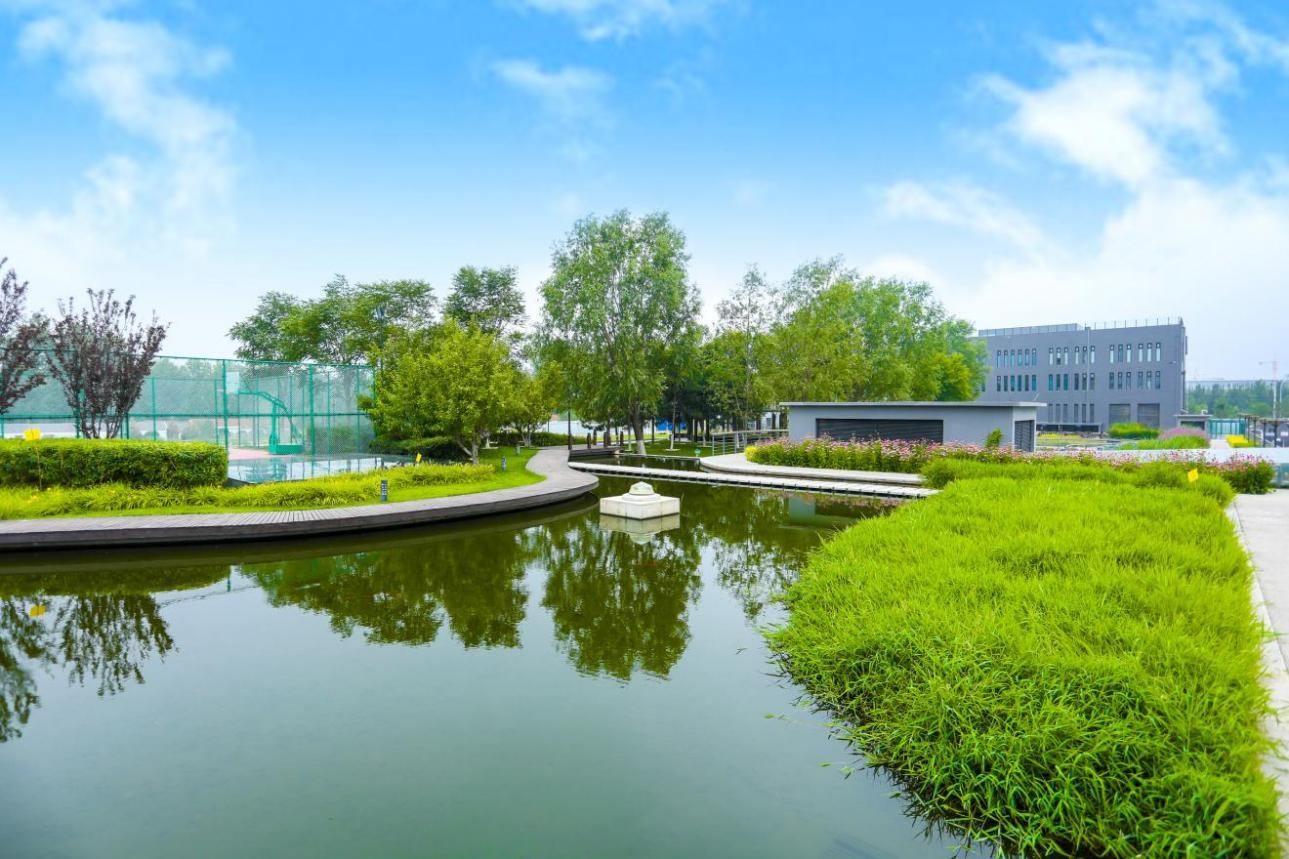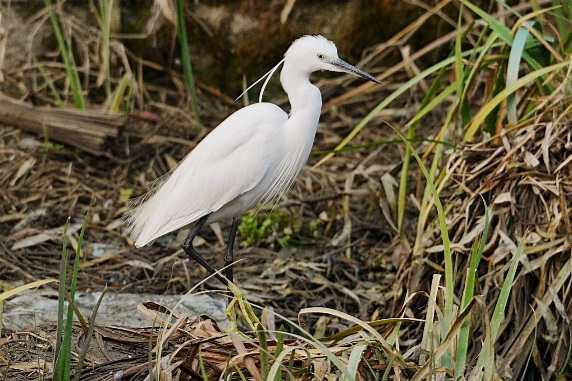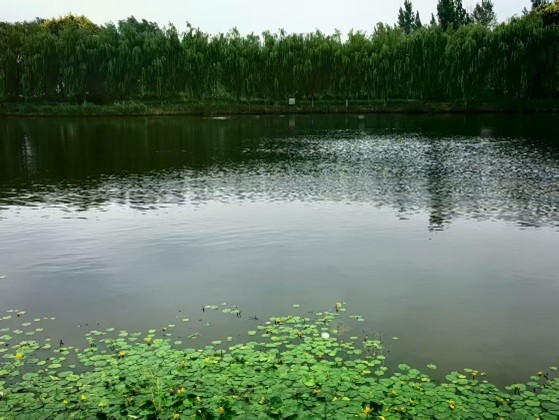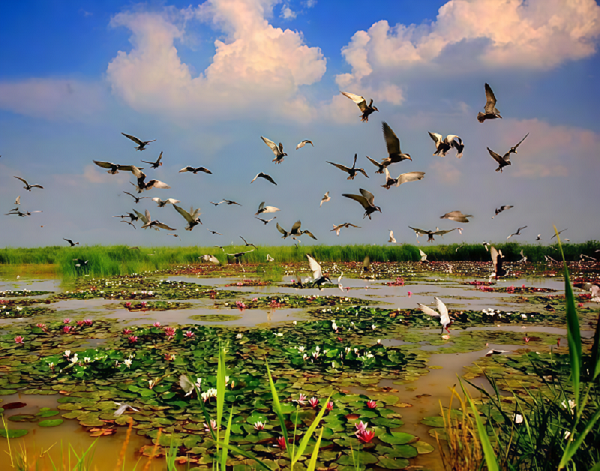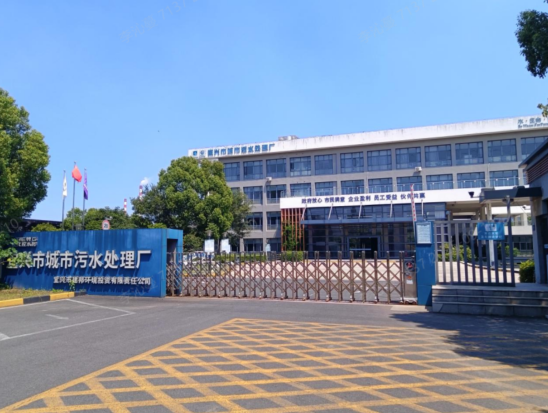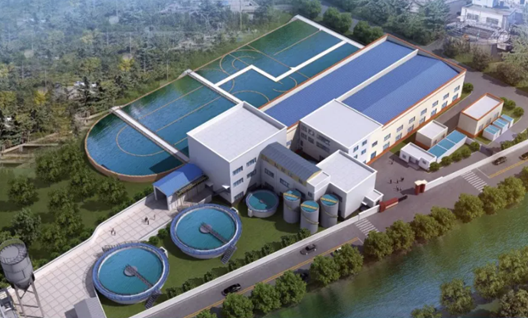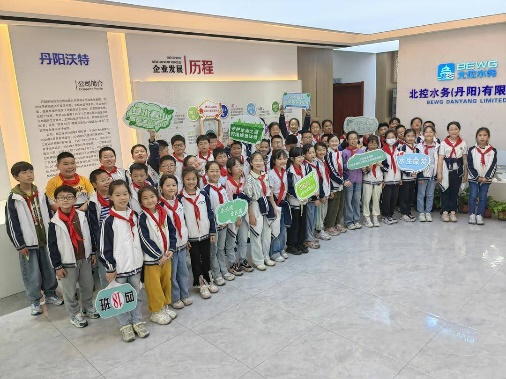We actively pursued energy-saving technological upgrades and adopted renewable and low-emission fuels instead of traditional energy sources to reduce the environmental impact of the water purification process. Committed to full-lifecycle ecological protection, we developed biodiversity-friendly products and technologies and actively carried out biodiversity protection and ecological restoration. We actively respond to national initiatives such as the China National Biodiversity Conservation Strategy and Action Plan (2011-2030) and strictly adhere to regulations like the Regulations on the Administration of Construction Project Environmental Protection. Our internal management system, the Biodiversity Protection Management Measures of BEWG1, is in place to continually enhance biodiversity-related governance system. Our overseas operational sites are also in strict compliance with local biodiversity protection requirements, shaping the image of responsible Chinese company.
We adopt the TNFD2-recommended framework of governance, strategy, risk and impact management, as well as metrics and targets, to strengthen the biodiversity governance structure, assess potential risks, clarify action plans, and continuously enhance the Group’s biodiversity management capabilities.
The Board, as the highest decision-making body, is responsible for identifying and determining material ESG matters and proposing recommendations for ESG objectives, policies, and structures. It also oversees the Group's overall strategy and supervises management. The Group established the Sustainability Committee, which oversees the implementation of specific ESG matters, reports ESG management progress and outcomes to the Board, defines material ESG issues, assesses climate-related risks and opportunities, reviews environmental target achievement, and evaluates the Company's ESG impact on stakeholders.
To ensure effective ESG management practices, an ESG Working Group comprising various business and functional departments has been set up to coordinate and drive the implementation of specific ESG projects, regularly reporting to management and the Board to ensure smooth ESG progress and effective risk prevention.
Meanwhile, we have integrated biodiversity protection-related management and oversight functions into the Board of Directors, the Sustainability Committee, and the ESG Working Group to improve the biodiversity governance system.
BEWG has referenced the TNFD-recommended LEAP3 approach to identify, assess, and prioritize the management of nature-related dependencies, impacts, risks, and opportunities material to its operational activities. Building on this, we adhere to a hierarchical action strategy of "Avoid, Reduce, Regenerate, Restore, and Transform"to mitigate biodiversity impacts through a systematic approach across the entire project lifecycle.
Locate
We utilize the Biodiversity Impact Assessment Tool4 and the Integrated Biodiversity Assessment Tool5 to conduct priority assessments of the ecological sensitivity at the Group's key operational sites6. We evaluated operational sites located within 10km and 50km radii of protected areas7 and key biodiversity areas8, respectively. Sites within 10km of protected areas or key biodiversity areas are classified as having high ecological sensitivity. We regularly identify and monitor species listed on the IUCN Red List9 and the China's Red List of Biodiversity10 in these areas, focusing on potential risks and actively deploying preventive and response measures.
Table 1 Biodiversity Impact Assessment Result
| Ecologically Sensitive Zone Assessment Indicators | Amount |
| Number of operational sites with high ecological sensitivity | 29 |
| • Number of operational sites within 10 km of protected areas | 16 |
| • Number of operational sites within 10 km of key biodiversity areas | 20 |
| Number of operational sites within 50 km of protected areas | 38 |
| Number of operational sites within 50 km of key biodiversity areas | 91 |
Table 2 Endangered Species Identification Results
| Ecologically Sensitive Zone Assessment Indicators | Amount |
| Total number of endangered species within 10 km of operational sites with high ecological sensitivity | 59 |
| • Number of species classified as Critically Endangered, Endangered, or Vulnerable on the IUCN Red List | 34 |
| • Number of species classified as Critically Endangered, Endangered, or Vulnerable on the China’s Red List of Biodiversity | 30 |
Evaluate
We utilized the ENCORE11to identify and evaluate the degree of dependency and impact of sewage treatment, water supply, and solid waste treatment business activities on biodiversity. The assessment results were further refined based on the actual operational context of the Group. Based on the materiality assessment outcomes, we will prioritize dependencies and impacts rated as "Very High" to lay the foundation for the Group's biodiversity-related risk management and the development of prioritized biodiversity protection action plans.
Table 3 Materiality Assessment Results of Biodiversity Dependency Factors
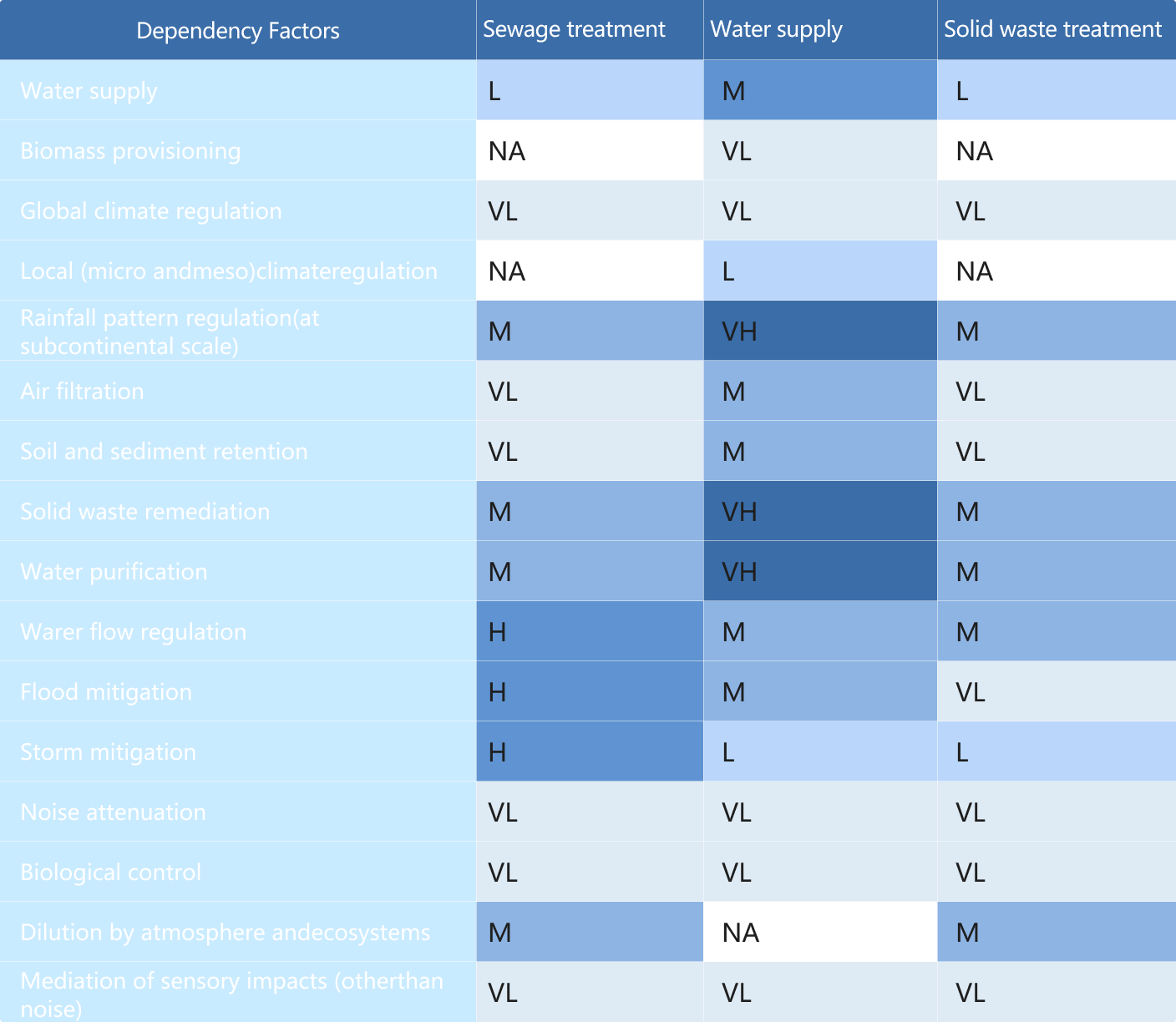
Table 4 Materiality Assessment Results of Biodiversity Impact Factors
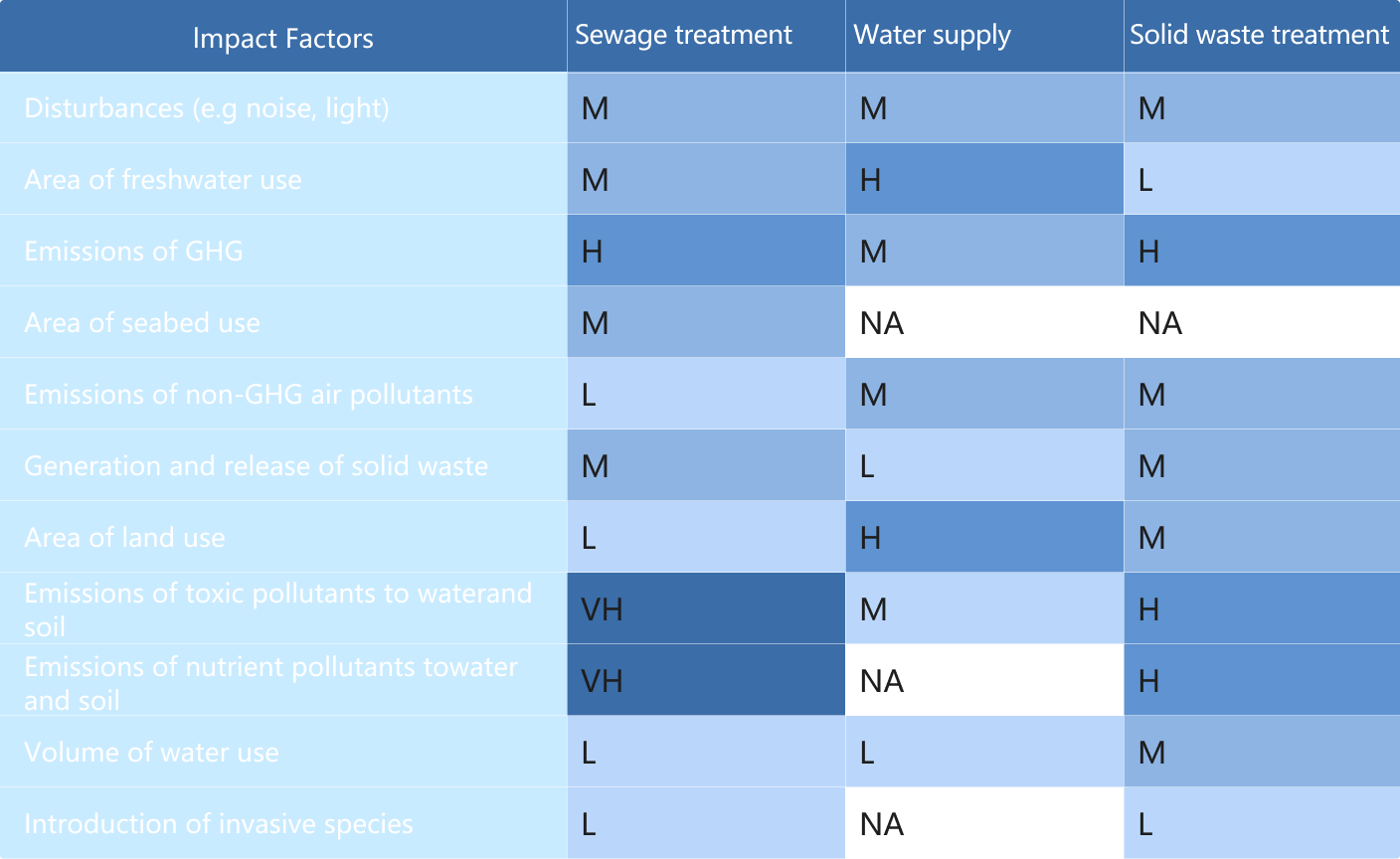

To effectively achieve the Group's ecological and environmental goals and realize the ecological and social benefits of environmental projects, we have strengthened the analysis of biodiversity-related risks and opportunities, and implemented comprehensive response actions across the categories of "Avoid, Reduce, Regenerate, Restore, and Transform".
Assess
Based on the results of the dependency and impact factor evaluation, we assessed biodiversity risks and opportunities with potential implications for the company, and developed targeted response measures to effectively manage these risks and opportunities.
Table 5 Biodiversity Risk Impacts and Response Measures
| Risks | Risks Impacts | Response Measures | |
| Physical Risks | Rainfall pattern | Regulation of Rainfall Patterns refers to the ecosystem contribution of vegetation and forests in maintaining rainfall patterns at a subcontinental scale through evapotranspiration. Forests and other vegetation recycle moisture back into the atmosphere, thereby generating rainfall. Precipitation in continental inland regions is entirely dependent on this cycle. The reliability of water sources for water supply services depends on the regulation of rainfall patterns by ecosystems to ensure the availability of water sources. Water scarcity may impact the stability of water supply operations, increasing water supply pressure and operational costs. |
Water supply business: • In terms of response measures on droughts, based on the actual geographical conditions of the projects, we increase the frequency of water quality monitoring for water supply projects in drought-prone areas, focusing on potential water quality deterioration issues caused by lowered water levels, and formulate relevant emergency response plans and water volume guarantee measures. • Minimise the impact of water shortages during droughts at the source, by actively encouraging and supporting local governments to prepare backup and emergency water sources. • Reach agreements with water source management entities on prioritising water supply to our projects during droughts. • Connect with the water supply pipeline network of other surrounding water supply entities to achieve mutual supplementation and ensure water supply safety in the event of insufficient water supply within one's own area. • Establish plans for emergency water intake when the water level at water sources is low. • Manage self-use water and reduce the leakage rate in a more effective manner, to better conserve water resources. |
| Solid Waste Remediation | Waste Remediation refers to the ecological contribution of ecosystems in transforming organic or inorganic substances into harmless forms through the actions of microorganisms, algae, plants, and animals. If ecosystems lose their capacity to convert organic/inorganic substances into harmless forms, pollutants cannot be effectively removed by natural processes. This may lead to deterioration of raw water quality, thereby increasing the process costs for water supply business. |
Water supply business: • Attach great importance to handling emergency situations by monitoring water quality anomalies monthly and formulating water quality improvement or emergency response plans for potential risk items, thereby ensuring a stable supply of high-quality water. • The Group has continuously optimised its internal management systems and standards. We established internal control standards and alarm mechanisms for water quality, revised the Standard for Raw Water Quality Grading Warning and the Control Guideline on Water Quality Abnormal Indicator, in which different raw water quality warning levels (I to IV) are designated for indicators such as turbidity, colour, and pH value, based on national standards. Additionally, these Standards provide various water treatment process guidance for water plants under different raw water quality conditions, while improving standardised emergency response procedures and responses to strictly ensure the water quality of the Group's water supply plants. • The Group's water supply projects actively explored and applied advanced treatment processes, and conducted special projects on water quality improvement, aiming to maximise the elimination of raw water quality risks and continuously improve water supply quality |
|
| Water Purification | Water purification services refer to the contribution of ecosystems in restoring and maintaining the chemical condition of surface water and groundwater. Through the decomposition or removal of nutrients and other pollutants by ecosystem components, they mitigate the harmful effects of contaminants on human use or health. Water supply operations rely on the water purification capacity of ecosystems to maintain or improve the quality of raw water, thereby reducing the need for artificial water treatment costs. |
||
| Pollutants release | Improper treatment processes or inadequate sewage treatment methods may lead to the release of toxic pollutants (such as heavy metals and chemicals) and nutrients (e.g., nitrates and phosphates) into soil and water bodies, resulting in pollution. | Sewage treatment business: • We continuously optimise the implementation details of assessments, emphasise the requirements related to influent management and effluent water quality. The effluent water quality of sewage treatment plants is monitored, tested, and evaluated by internal departments, government departments, and third-party testing agencies commissioned by government departments. In 2024, the effluent water quality compliance rate of BEWG’s sewage treatment plants reached 100%. • We established a star-level evaluation system for enterprise operation, to carry out acceptance evaluations with a high-standard operational grading evaluation system and strict management measures, assisting sewage treatment plants in continuously improving their operational performance, stabilizing the effluent water quality performance. In 2024, all BEWG’s sewage treatment plants completed the star-level operational evaluation assessments and acceptance, with 34.4% of the plants rated "three-star" and above, while the high-star plants ratio was gradually increasing. • To promote the deployment of the Group's digital strategy, we continue to deepen the construction of standardised and intelligent sewage treatment plants to improve the quality and efficiency of operation. • In response to sudden influent shock and irregular influent fluctuations faced by sewage treatment plants, we have established an emergency management mechanism for influent shock and a long-term management mechanism for influent shock, consolidated internal and external emergency response capabilities, collaborated with government departments and upstream enterprises, thereby effectively enhancing the operational stability of sewage treatment plants, and ensuring the water quality. |
|
| Transition Risks | Policy | The Ministry of Ecology and Environment issued the China Biodiversity Conservation Strategy and Action Plan (2023-2030), which clarifies the strategic deployment, priority areas, and priority actions for biodiversity conservation in China, providing guidance for advancing biodiversity protection. Failure to promptly respond to policy changes may lead to potential compliance risks. | Sewage treatment, water supply, and solid waste treatment business: • Closely monitor policy trends and changes, conduct regular reviews of laws and regulations, implement employee training and dissemination on relevant legal requirements, and actively participate in discussions within relevant industry associations. • Proactively carry out biodiversity protection efforts at operational sites, integrate protective measures throughout the project lifecycle, and avoid compliance risks. |
| Reputation | Stakeholders such as investors, regulatory agencies, and clients are increasingly attentive to corporate performance in biodiversity. If project operations incur significant negative ecological impacts, it may trigger public opinion crises, potentially leading to diminished client trust, reputational damage to the brand, and other risks. | Sewage treatment, water supply, and solid waste treatment business: • Implement biodiversity protection measures tailored to local conditions to enhance the ecological and environmental value of projects; • Proactively disclose information related to biodiversity protection, and improve the transparency of the Group’s environmental governance through initiatives such as open site visits and online educational videos. These efforts demonstrate the outcomes of biodiversity protection work. |
|
Table 6 Biodiversity Opportunities Impacts and Response Measures
| Opportunities | Opportunities Impacts | Response Measures |
| Policy | As the national and governmental emphasis on biodiversity intensifies, relevant policies are being progressively introduced. The company will play a critical role in ecological protection and restoration projects. | Sewage treatment, water supply, and solid waste treatment business: • Closely monitor national and local policies, regulations, and industry standards related to biodiversity protection, promptly adjust project planning to ensure compliance with policy requirements, and actively seek policy support and funding opportunities. |
| Reputation | By actively protecting biodiversity, enterprises can shape a "green and responsible" brand image, thereby enhancing brand recognition. | Sewage treatment, water supply, and solid waste treatment business: • Expand communication and dissemination channels for biodiversity-related information, and actively showcase progress and achievements in related work. |
Prepare
Based on the assessment results of risks and opportunities, we adopt "Avoid, Reduce, Regenerate, Restore, and Transform" as the guiding principles for biodiversity protection actions. We integrate the concept of biodiversity protection into project operations and develop targeted conservation measures that cover the entire project lifecycle.
Table 7 Direction and Measures for Biodiversity Protection Actions
| Direction of biodiversity protection actions | Protection Measures |
| Avoid | • In the planning and design stage, we conduct ecological basic investigation, assessing the environmental impact, mainly considering factors related to biodiversity protection, with the aim of avoiding the negative impact of the project on the ecological environment from the source; • Focus on preventing and controlling factors like light pollution, noise pollution, and environmental pollution that have impact on the surrounding ecosystem of project sites. |
| Reduce | • We implement regular monitoring, strict abide by environmental supervision systems, establish an environmental management archive, and record in detail environmental monitoring data, abnormal data processing procedures and results; Adopt materials, devices, and equipment that facilitate biodiversity protection; • In the construction stage, we monitor changes in biological indicators during operation in real time with the smart water system, timely identifying biological risks and responding to them promptly; • Implement drainage system renovations to increase sewer network collection rates and reduce unorganized discharge of pollutants into natural water bodies; • Conduct sludge reduction, stabilization, harmless treatment, and resource recovery processes at sewage treatment plants to mitigate risks of soil and water contamination, thereby alleviating pressure on the ecological environment from the source. |
| Regenerate | • Plant vegetation along riparian zones adjacent to water bodies to increase plant coverage and provide habitats for shoreline species; • Establish aquatic biological ecosystems to rapidly restore riverine ecological stability, enhancing biodiversity protection and aesthetic value. • Develop and apply various green infrastructure products and technologies, represented by artificial wetlands. Combining wastewater treatment with ecological protection, we develop green and low-carbon wastewater treatment processes. |
| Restore | • In the planning and design stage, giving priority to the protection of local characteristic species and their habitats, and developing special protection and restoration plans. • Adopt restorative measures, such as creating environments conducive to the survival of species in the food chain to enhance biodiversity on a small scale; • Implement ecological water replenishment projects by diverting high-quality effluent from sewage treatment plants to recharge natural water bodies, ensuring the ecological water demand of aquatic systems is met; • The Group continuously promotes the industry-university-research cooperation, conducts research and development of in-situ water ecological restoration technologies, and furthermore applies them in engineering practices. |
| Transform | • Conduct biodiversity publicity and education for employees, and actively convey the concept, progress and achievements of biodiversity protection to external stakeholders, to advocate green environmental protection and biodiversity protection, raise the awareness of biodiversity protection among all parties, and call on all stakeholders to jointly protect our green homeland. • Conduct specialized biodiversity research and collaborate with national authorities and professional institutions to promote industry-specific and enterprise-specific development; • Establish a star-rated operational enterprise evaluation system to enhance the operational quality and efficiency of water treatment plants. This system comprehensively assesses enterprises across five dimensions: process management, operational quality, business outcomes, personnel capabilities, and digital operational capacity. Indicators such as energy consumption, safe sludge disposal, water quality compliance, and the implementation of eco-friendly public initiatives are incorporated into the star-rating criteria and linked to employee performance evaluations. This approach aims to raise ecological protection awareness among staff and drive water treatment plants to adopt conservation measures. |
BEWG has established biodiversity protection targets and regularly tracks progress and outcomes in biodiversity protection, thereby guiding and ensuring the effective implementation of all conservation actions.
| Biodiversity Protection Targets |
| • Ensure a balance between habitat protection and sustainable utilization in project development and operational activities, achieving no net loss of biodiversity through measures such as ecological restoration. • Collaborate with value chain partners (including suppliers and contractors) in project development and operational activities to achieve the target of zero net deforestation. |
| Indicators | 2024 | Unit |
| Number of Major Accidents in Violation of Environmental Laws and Regulations | 0 | Case |
| Proportion of New, Reconstruction, and Expansion Projects Conducting Environmental Impact Assessment | 100 | % |
| The effluent water quality compliance rate of BEWG's sewage treatment plants | 100 | % |
| Reduction in COD | 1,117,822 | Tonnes |
| Reduction in ammonia nitrogen | 143,590 | Tonnes |
| Reduction in total phosphorus | 19,711 | Tonnes |
| Reduction in suspended solids | 859,752 | Tonnes |
| Total reduction in pollutants | 2,140,875 | Tonnes |

